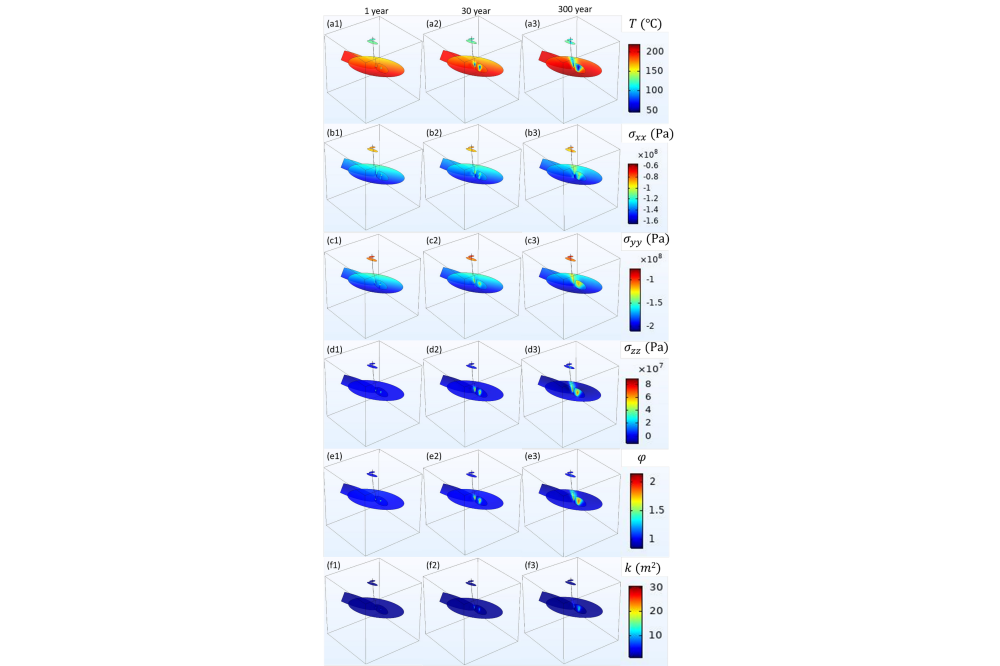Direct Numerical Simulation of Thermo-Hydro-Mechanical Processes at Soultz-sous-Forêts
Introduction
Enhanced Geothermal Systems (EGS) exploit the Earth's geothermal energy resources, especially in areas with low permeability and little natural water content. The technology leverages geological formations primarily fractured rocks, to create a network of fractures to facilitate fluid flow, often using hydraulic, chemical, or thermal stimulation. This work develops a Thermo-Hydro-Mechanical (THM) model of an EGS at Soultz-sous-Forêts, France, which began commercial production in 2016. The model examines the interplay between porosity, permeability, and stress, to understand how pressure and temperature changes affect the THM processes. Addressing previous research limitations, it considers both large-scale fractures and equivalent porous media. High Performance Computing (HPC) resources are crucial for handling the model's complex calculations and large datasets. This study aims to optimize EGS performance by refining our understanding of heat extraction from geothermal reservoirs.
Methods
This study investigates cold fluid injection and hot water production's impact on the Soultz-sous-Forêts geothermal reservoir. We employ numerical simulation to evaluate thermo-poroelasticity response of rocks under pressure and temperature changes. Our model, validated with existing operational data and literature, assumes an 8km-sided cubic homogeneous and isotropic matrix zone around injection and production wells. The simulation uses recent data on well flow rates and field measurements for well trajectories and fracture zones. We've defined model boundaries for fluid flow, heat transfer, and geomechanics, factoring in elements like insulation, heat flux, and displacement constraints. Initial temperature and pore pressure rely on regional geothermal gradient and hydrostatic pressure. We envisage homogeneous flow across injection and production intervals without examining wellbore heat loss. Simulations are solved using COMSOL Multiphysics 5.5 via the finite element method, with tetrahedral meshes for precision.
Results
This study investigates the impact of cold fluid injection and hot water production on the thermo-hydro-mechanical processes within the geothermal reservoir at Soultz-sous-Forêts. The research explores the relationship between porosity, stress, and permeability through sensitivity analyses using nine different scenarios. The results show that thermal breakthrough is not observed for the entire operation at the given injection and production rates. As the cold front develops around the injection wellbores, thermoelasticity combined with poroelasticity leads to a decrease in compressive stress. It is important to note that the impact of poroelasticity is mainly concentrated around the wellbores, while thermoelasticity affects a wider region. Injection of cold fluid increases the tensile stress in all directions, leading to an increase in porosity in the affected areas. In some regions, the porosity can double, and this variation is mainly controlled by the fracture aperture variation. Additionally, a small change in porosity can have a significant impact on permeability values, leading to localized increases in permeability around the wellbore regions.
Discussion
This research thoroughly investigates the thermo-hydro-mechanical processes in Soultz-sous-Forêts' geothermal reservoir, emphasizing cold fluid injection and hot water production's impact. The study illuminates the intricate dynamics between temperature, stress, porosity, permeability, and their significance in reservoir performance. We conducted a sensitivity analysis using nine scenarios to comprehend these factors' interrelation. Findings reveal no thermal breakthrough during operation and a cold front around injection wellbores causes compressive stress reduction due to thermoelasticity and poroelasticity. Poroelastic effects primarily impact wellbore areas, while thermoelasticity influences a broader region. Cold fluid injection raises tensile stress uniformly, leading to porosity growth in affected zones. This porosity shift, chiefly governed by fracture aperture variation, potentially results in substantial localized permeability increase around wellbore regions. While these findings enrich our understanding of geothermal reservoir behaviour, certain limitations, including overlooking fracture initiation and propagation due to stress variations, exist. Future research must focus on these aspects, different operational scenarios, geochemical reactions, and their influence on porosity and permeability changes for more sustainable and efficient energy production.




